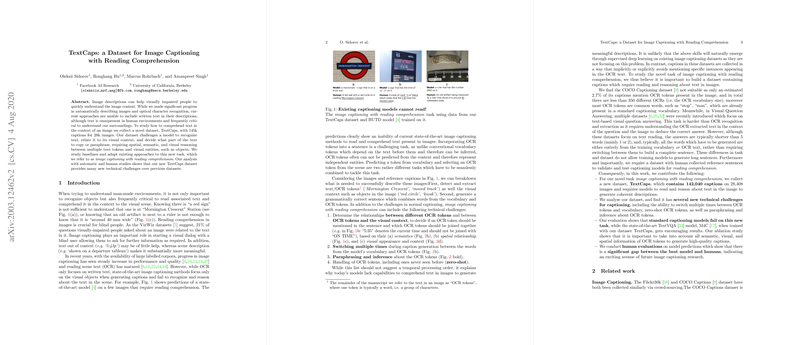TextCaps: A Dataset for Image Captioning with Reading Comprehension
The paper presents the TextCaps dataset, which aims to address the challenge of image captioning with the inclusion of reading comprehension. This dataset is intended to bridge the gap between traditional image captioning, focusing solely on objects within an image, and the comprehension of text embedded in a visual context. The primary motivation stems from the need for systems that can generate captions by reading and understanding text present in the images, a task especially beneficial for visually impaired users who depend on detailed image descriptions.
Dataset Composition and Objectives
TextCaps comprises approximately 145,000 captions across 28,000 images. The dataset challenges models to recognize text (as OCR tokens), relate it to visual content, and integrate these elements into coherent sentences. Therefore, it goes beyond conventional image captioning, where the focus lies on object recognition and description, demanding a higher level of reasoning that includes spatial, semantic, and visual understanding.
While existing datasets like COCO focus on prominent objects and minimize text components, TextCaps requires the comprehension of textual information as a significant component of the scene, often needing the models to infer, paraphrase, or directly copy text. The dataset also highlights the inadequacy of contemporary captioning models to process text in visual scenes effectively, which is emphasized through comparative analysis with established benchmarks.
Methodological Analysis
The paper evaluates traditional captioning models, such as BUTD and AoANet, alongside advanced models like M4C. It emphasizes how current models trained on datasets like COCO are ill-suited for tasks requiring text comprehension due to their lack of mechanisms for processing and integrating OCR tokens into model outputs. The M4C model, adapted with features like a pointer network for dynamic word generation, shows promising results by integrating automatically detected OCR tokens, addressing text comprehension more accurately than its counterparts.
Experimental Findings
When trained on TextCaps, the M4C model outperforms traditional models by a significant margin. The paper's results, however, show a notable performance gap between machine-generated captions and human reference captions, illustrating the dataset's complexity and the task's challenges.
The paper details evaluations primarily through automatic and human-centered metrics, demonstrating a high correlation between CIDEr scores and human evaluations. Nevertheless, the model's ability to switch seamlessly between vocabulary and OCR tokens stands out as a critical success factor, as observed through the analysis of the dataset's technical demands.
Implications and Future Directions
TextCaps introduces several layers of complexity to the field of image captioning. By creating a necessity to blend textual and visual elements, the dataset drives the development of more sophisticated AI models capable of richer, contextually-dependent text generation. This dataset is a notable step towards systems that can significantly aid visually impaired users in interpreting their environments, aligning with accessibility aims.
Future research will likely focus on improving model architectures to better handle zero-shot OCR token scenarios, enhancing semantic reasoning, and utilizing external knowledge bases to resolve text ambiguities. The TextCaps dataset thus serves as a catalyst for advancement in multimodal AI, promoting a synthetic understanding of visual and textual data within computer vision applications. The continued progression in this space holds significant promise for more dynamic and interactive AI systems that can perform complex perceptual tasks.
In conclusion, the TextCaps dataset and its associated challenges provide a valuable framework for enhancing image captioning models, moving beyond object description to incorporate the comprehension of text within visual contexts, thereby paving the way for more refined AI capabilities.
